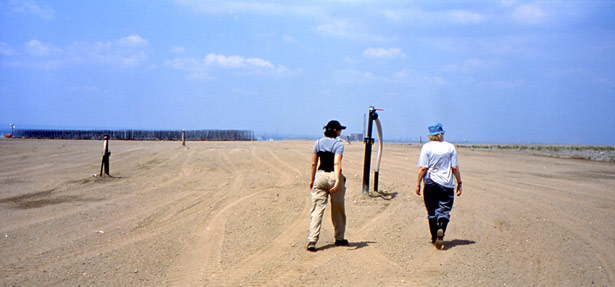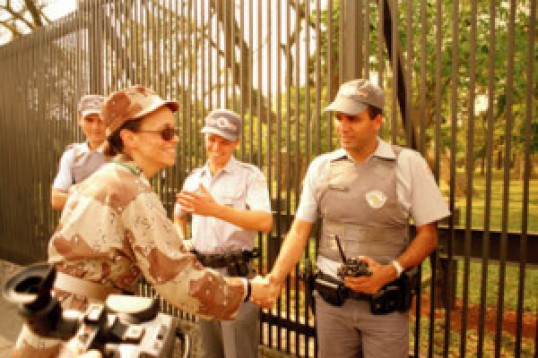James Bridle is reclaiming the air, once the realm of utopia and progress, now reserved for surveillance and control:
intervention
Arresting Blair
Brilliant, someone just made the 5th attempt to do a citizen’s arrest of Tony Blair, on grounds of crimes against humanity.
CfPP: Gewächshaus Erinnerung – a project by thon&beuse
The project Gewächshaus Erinnerung by thon&beuse is concluded: documentation online under
http://www.thonbeuse.com/reaction-gewaechshaus.html
Gewächshaus Erinnerung
Performative Installation, 30 Tigerbambusrohre, 2000 Meter imprägnierter Baumwollfaden, 100 Meter schwarzes Nylonseil, 100 Meter weisses Nylonseil, Draht, 1000 Sandwichboxen transparent, gesammelte/gespendete Erinnerungsstücke, gegossener Wurfanker, 2 Schekel. thonbeuse 2010
Schlagworte (Tags) Bewegungsmuster, Intim/Öffentlich, Erinnerungsmuster, Topographische Vernetzung/Verteilung, Erinnerung/Raum, Architektur, Baugeschichte, Erinnerung/Ritual, Erinnerung/Wandel, Kunst/Wort
CfPP: Scratching in Vogelsang
>vorübergehend<
Thon&Beuse still scratching in former NS->Ordensburg< Vogelsang.
Interview with the artists broadcasted by public sender WDR.
http://alturl.com/ap6p
SFAI Hosts Mierle Laderman Ukeles: Ann Chamberlain Distinguished Fellow in Interdisciplinary Studies
The San Francisco Art Institute is pleased to welcome New York City–based artist Mierle Laderman Ukeles as the inaugural Ann Chamberlain Distinguished Fellow in Interdisciplinary Studies.
A major intervention in feminist performance practices and public art, Mierle Laderman Ukeles’s 1969 manifesto Maintenance Art: Proposal for an Exhibition argues for the intimate relationship between creative production in the public sphere and domestic labor—a relationship whose intricacies and ramifications she has been unraveling, in one form or another, ever since. Starting in 1977, she became artist-in-residence (unsalaried) at the New York City Department of Sanitation, a position that enables her to introduce radical public art as public culture into a system serving and owned by the entire population. Recent permanent commissions include Percent-for-Art Freshkills Park Project in New York City (formerly the world’s largest municipal landfill), Danehy Park in Cambridge (Massachusetts, USA), and the Maine College of Art in Portland (Maine, USA). Current and recent temporary exhibitions include performances and installations at the Barbican Art Gallery in London, the Montalvo Arts Center in Saratoga (California), the Contemporary Jewish Museum in San Francisco, the Museum of Contemporary Art in Los Angeles, Creative Time in New York City, the Tel Aviv Museum of Art in Tel Aviv (Israel), and the 2007 Sharjah Biennial in Sharjah (United Arab Emirates). She has completed six “work ballets” that involve workers, trucks, barges, and hundreds of tons of recyclables in cities across the globe. Laderman Ukeles is a Guggenheim Fellow and a recipient of many grants and fellowships from the NEA and the New York State Council on the Arts.
San Francisco Art Institute (SFAI)
800 Chestnut Street
San Francisco, CA 94133
800 345 SFAI / 415 749 4500
Monday, May 3 – Wednesday, May 5, 2010
No Territory: AnarchoArtLab at The Living Theater
http://www.livingtheatre.org/
Sunday January 17th, 8pm – Midnight @ THE LIVING THEATER
No Territory: The AnarchoArtLab will respond to the news that our home and a brave New York institution, The Living Theater, will shutter its doors in 2010. This multi-media, interdisciplinary event will plumb the varied meanings of territory, property, ownership, and the individuals right to movement, thought, and expression in an “Ownership Society.”
The golden age was the age when gold didn’t reign; the cause of all wars, riots and injustices is the existence of property, happiness is hanging your landlord!
The wind is turning. The economy is wounded — we hope it dies! Amnesty is an act in which the rulers pardon the injustices they have committed; the state’s magnanimity to those offenders whom it would be too expensive to punish.
Abolish alienation! Obedience begins with consciousness; consciousness begins with disobedience! First, disobey; then write on the walls!
– graffiti, Paris, 1968
AnarchoArtLab is a collective of new-media, visual artists, performers, musicians, dancers and genre benders in residence at The Living Theatre. Each month we create a LIVE, collaborative, multi-media art experience that is both immersive and participatory. We welcome you to come for an hour or experience the entire evening.
Artists include but are not limited to: Glass Bead Collective, David Tully, Grady Gerbracht, John Loggia, Adriana Varella, Z-Collective, James ChrisBunny! Fields, Michele Cappello, Takashio Hisayasu, Miles Pflanz and Jackie Connolly, Parker Miller and English.
thonbeuse present "vogelsang site walks II: "Blickpolitik" eine "Vogelsang Konversion" neu mit Nothammer"
Dies ist eine Projektskizze, die sich grundsätzlich als temporäre Erinnerungseinrichtung eignet, im konkreten Fall bezieht sie sich beispielhaft auf das Informationszentrum vogelsang ip’s – eignet sich aber grundsätzlich für Orte an denen die “Blickpolitik” eine Rolle spielt. Im Rahmen der sogenannte “Vogelsang Konversion” spielt die Steuerung der Wahrnehmung, der Blicke und Eindrücke eine wichtige Rolle. Diese Projektskizze ist gegenwärtig eher als ein kleiner Essay zu verstehen, die tatsächliche Realisierung des Projektes steht nicht im Vordergrund. Die grundsätzliche Frage ist die nach der Schuld/Unschuld des Blickes, also nach der Inszenierung von Blicken und den dadurch ausgelösten Emotionen/Denkprozessen vor dem Hintergrund der Geschichte Vogelsangs als Bildungseinrichtung des NS-Faschismus.
http://www.thonbeuse.com/Blickpolitik-Vogelsang-Konversion.html
Coco Fusco at MC
http://www.afterall.org/online/coco.fusco.at.mc
Coco Fusco’s recent exhibit at MC, Los Angeles (2006) included the photographic series Bare Life Study #1, a fictional military interrogation training manual for women, an enigmatic presentation of real manuals on a desk, and in an adjoining room, the 59-minute video Operation Atropos. The show explored the weaponization of female sexuality by the US military that was exposed by the Abu Ghraib and Guantanamo Bay prisoner abuse scandals.
read more!
Art and Its Cultural Contradictions, Joshua Decter
http://www.afterall.org/journal/issue.22/art.and.the.cultural.contradictions.of.urban.regeneration.social.justice.and.sustainability
What is at stake when artists, architects, curators, organisers and other cultural producers facilitate bricks-and-mortar change, on the ground in cities, with citizens, communities and institutions? How do we test the interrelationships between the practices of artists and urban policy makers? What is the metric that we might utilise to determine effectiveness? And what do we mean by effectiveness? Critical effect? (Or, for that matter, critical affect?) The putatively emancipatory outcome generated by some kind of new situational knowledge? Or, is it a question of generating ambiguity, per se, as a means of problematising hegemonic political, economic and cultural formations?
read more…


